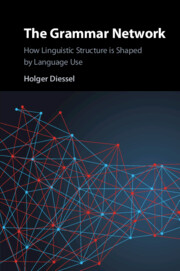Book contents
- The Grammar Network
- The Grammar Network
- Copyright page
- Contents
- Figures
- Tables
- Preface
- Abbreviations
- 1 Introduction
- Part I Foundations
- Part II Signs as Networks
- Part III Filler–Slot Relations
- 7 Argument Structure and Linguistic Productivity
- 8 A Dynamic Network Model of Parts of Speech
- 9 Phrase Structure
- Part IV Constructional Relations
- References
- Author Index
- Subject Index
9 - Phrase Structure
from Part III - Filler–Slot Relations
Published online by Cambridge University Press: 12 August 2019
- The Grammar Network
- The Grammar Network
- Copyright page
- Contents
- Figures
- Tables
- Preface
- Abbreviations
- 1 Introduction
- Part I Foundations
- Part II Signs as Networks
- Part III Filler–Slot Relations
- 7 Argument Structure and Linguistic Productivity
- 8 A Dynamic Network Model of Parts of Speech
- 9 Phrase Structure
- Part IV Constructional Relations
- References
- Author Index
- Subject Index
Summary
Constituent structure is commonly represented in phrase structure trees, which one might analyze as some kind of network. However, while phrase structure graphs are useful to explain certain aspects of syntactic structure, they are not fully compatible with the dynamic network approach, as these graphs are built from primitive concepts. Challenging the traditional approach, Chapter 9 outlines a dynamic network analysis of constituency in which the hierarchical organization of linguistic structure is emergent from the interaction of several domain-general processes, including conceptualization, automatization, analogy and abstraction, which together account for both the syntactic generalizations that have been in the focus of formal syntax and the many idiosyncracies that reflect the influence of speakers’ experience with particular constructions. The proposed analysis casts a fresh light on syntactic constituency and has far-reaching implications for the theory of phrase structure and the analysis of word order correlations.
Keywords
Information
- Type
- Chapter
- Information
- The Grammar NetworkHow Linguistic Structure Is Shaped by Language Use, pp. 172 - 196Publisher: Cambridge University PressPrint publication year: 2019
